December 25, 2007
Peace on Earth

SG by me - Season's Greetings.
and please, for all, a Happy and Peaceful New Year.
December 24, 2007
Christus natus est!
Boy, is it hard to find an unconventional Nativity window.
But, finally, I found this - the Nativity Window, designed by John Piper, and fabricated by David Wasley. It's a little hard to tell from the research, but it seems to have originally been created as an exhibition piece in the early 1980's and ended up, in the mid 1990's, residing at St. Mary's Church, Iffley in Oxfordshire, England.
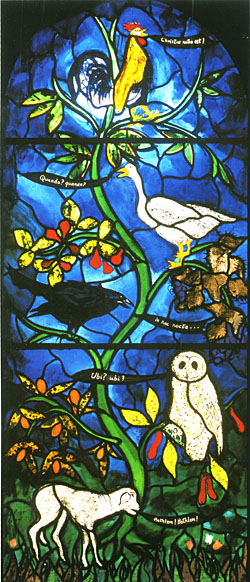
The basic idea comes from the fanciful notion that animals can speak on Christmas Eve, seeing that they were present at the birth of baby Jesus. -
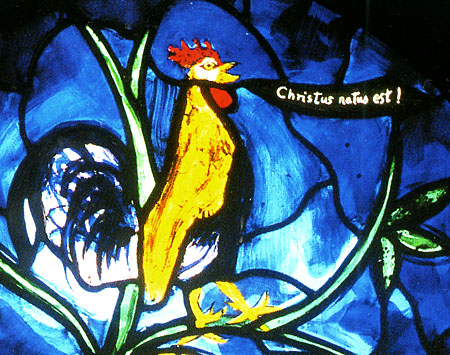
COCK - Christus natus est (Christ is born),
GOOSE - Quando? Quando? (When? When?),
CROW - In hac nocte (On this night),
OWL - Ubi? Ubi? (Where? where?),
LAMB - Bethlehem! Bethlehem!
The sounds of the Latin words resemble the noises made by the animals and birds. Underneath (not seen in this image, alas) is a line from Christopher Smart: "Let man and beast appear before him and magnify his name together."
I've liked this window if only for the highly unusual use of speech balloons in 20th century stained glass. I especially like how they actually look more like a cross between the newer speech balloon and the older speech scroll.
This window is also featured, along with several others designed by John Piper, in the book, Faith, Hope and Light. Nice book, with a diverse array of stained glass design styles.
You can see other John Piper windows in the John Piper Flickr Set by oxfordshirechurches. You can also this window as part of a Flickr Set of St. Mary's, Iffley from Flickrite and stained glass enthusiast Lawrence OP.
December 19, 2007
A Glass Half Empty
An interesting and entertaining article, by arts writer Waldemar Januszczak, called A glass half empty at the National Gallery's Art of Light in the TimesOnline. It's a review of the 'Art of Light: German Renaissance Stained Glass' exhibition at London's National Gallery. I should note that it's a mostly negative review of the exhibit though tempered by an enthusiastic rave about stained glass.
just one among a number of curious kernels of thought -
... His contention was that stained glass avoids the brain altogether and appeals directly to the nervous system. In other words, you canít help feeling what you feel in front of coloured glass. It doesnít matter if the artist who made it is good or bad. When light passes through glass, it does something to you.
By way of contrast, here is another, more straightforward, review of the exhibition. This one has a number of images from the exhibit...
...including this one of the Tobias and Sarah panel described by Januszczak in the TimesOnline article.
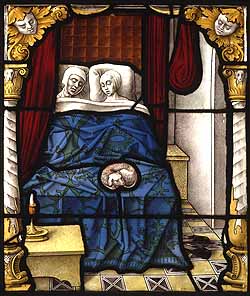
German (Lower Rhine), Tobias and Sarah on their Wedding Night, about 1520. © V&A Images/ Victoria and Albert Museum, London
And one more article, this time by Jonathan Jones in the Guardian. He muses about the limited value of showing stained glass in a museum setting. He has a point. There is nothing like natural light.
December 16, 2007
Vidimus 13, The King's Glass, and The Treasure of Abbot Thomas
Vidimus, which boasts of being the only online magazine devoted to medieval stained glass, has been around for about a year and is always worth a look through.
The December 2007 issue reviews the new book The King's Glass, by Carola Hicks. Amazon describes the book as such - "Monarchs and makers. The tense, captivating story of the glorious windows of the King's College Chapel, Cambridge". Translation - the book is about the stained glass of King's College Chapel, with a focus on the makers of the glass, mostly Flemish immigrants. Sounds like a great premise for a book, as there are far too few books on stained glass that deal with the designers and fabricators who actually make the stained glass. You can see other reviews of The King's Glass at the Telegraph online and the Times Online.
I visited King's College Chapel about 17 years ago and I have to say I liked the side chapel glass better than the big bold scenic windows. Just me, as I tend to prefer the small and intimate spaces over the large and overpowering. There is no mention of it in this issue of Vidimus, but if you can find it, look for Hilary Wayment's book on the King's College Side Chapel Glass. On writing this, I tried a search for 'hilary wayment chapel glass' at abebooks.com, and I've seen it on other used book sites. If you just want to see more images of the stained glass from King's College Chapel, the great and the intimate, you can see many images with a Flickr search for 'king's college chapel glass'.
a few examples, among many -
The Top portion of the East Window - in full
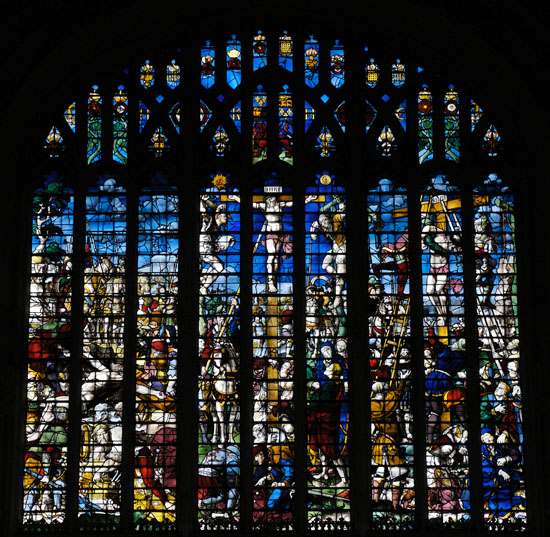
via Flickrite "nick in exsilio"
and a closer view in the lower center area - see Christ's foot at the top left in the image. I remember this as a large expanse of glass with a jumble of highly colored figures.
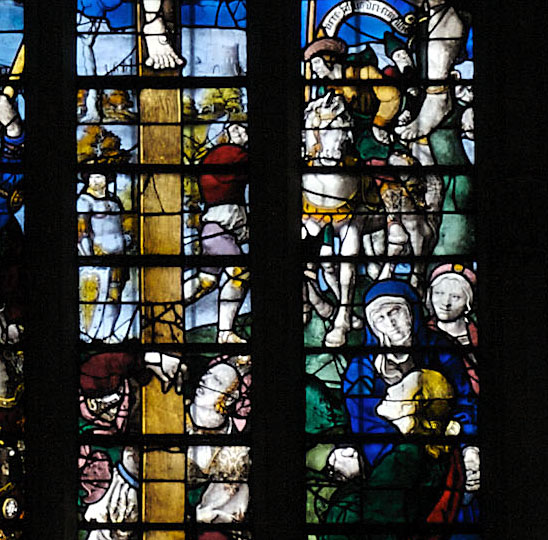
As for the Side Chapel windows, this is one of the more enigmatic of the side chapel roundels.
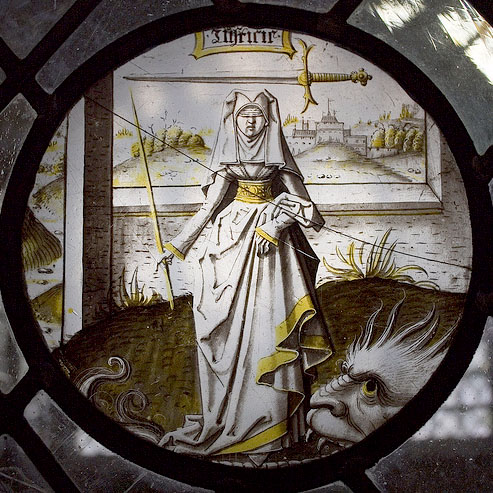
"Justice" - via flickrite twistan
Another view of the side chapel windows. This gives a better idea of the context in which you might see these, in a jumble of a different sort. Note the grasshopper - the side chapel windows contain many of these small 'nature' themed details.
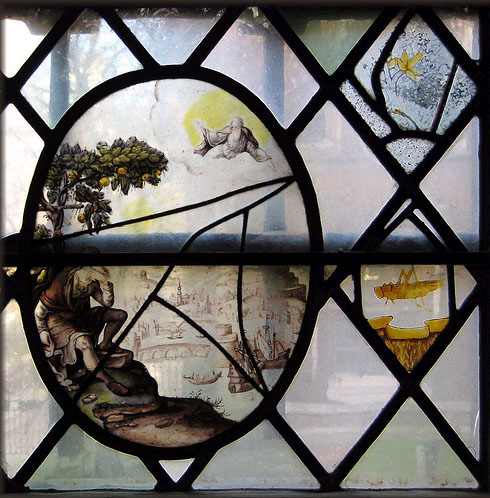
via flickrite 'frscspd'
This issue of Vidimus being the Christmas issue and there being a tradition in England for the Christmas Ghost Story, there is included a ghost story by M.R. James called The Treasure of Abbot Thomas, which features stained glass in a key part of the plot. I read the story many years ago and it was fun to read it again. Well, actually, I listened to it this time. You can find links to free audio versions of all the stories in "Ghost Stories of an Antiquary" at Librivox, which turns public domain books into downloadable audio book versions.